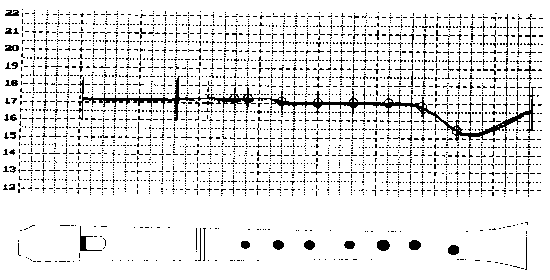3 Early baroque recorder
In the title of this talk, the next name specified is “Kynsecker”, a representative of early baroque recorder-making.
3.1 Which is the Early Baroque Recorder?
The question “Which is the typical recorder of the early baroque?” is difficult to answer. It was a transition period, and the surviving instruments are from quite different building method. We are dependent on relatively few instruments and written sources, with which however some characteristics crystallize. We will simply look at two important sources:
The best-known instruments from this epoch are a consort of 2 each of Sopranos, Alto and tenor recorders, and a bass of Hieronymus Franz Kynsecker of Nuremberg, which are store there today in the Germanic National Museum. These were developed only in the second half of the 17th century, but their evidently conservative building clearly reflects methods of 50 years earlier.
Kynsecker was not necessarily the greatest maker in his guild. His instruments are above all important because of their relatively good state of preservation and their distinctive shaping with the characteristic wave profile at the head pieces. Their quality of tone and speech quality are probably to be regarded at best as moderate, so that they represent more an interesting study material than a worthwhile model for reconstruction.
An interesting written source is represented by Jacob van Eyck’s “Fluyten Lust-Hof” in which the author provides, at the beginning, a short tutorial for the “handfluyt”, common at that time, in which he essentially gives the baroque fingerings common today, apart from the different fingering for the fourth note, which we have since come to call “historical” fingerings.
These fingerings, which we rely upon above all for the third register, almost always work on the original instruments of this time.
3,2 Building Characteristics
From the design point of view, throughout the first half of the 17th century, the instruments further developed as an advancement of the “classical” Renaissance recorder type, with a clear contraction of the bore at the lower end, which otherwise was often almost cylindrical or with a very slightly reverse conical bore. The finger holes are usually obviously closer together than with the old Consort recorders. Also the cut-up becomes somewhat larger.

Bore diagram of an early baroque recorder
3,3 Effect on Tone Quality
The tone quality of these instruments became, in comparison with former times, clearly more rich in overtones and more “soloistic”, the typical baroque sound developed, with its reedier becoming more evident.
The instruments most probably were however usually still able to be mixed and we might assume were often still played together in consorts along with Kynseckers.
